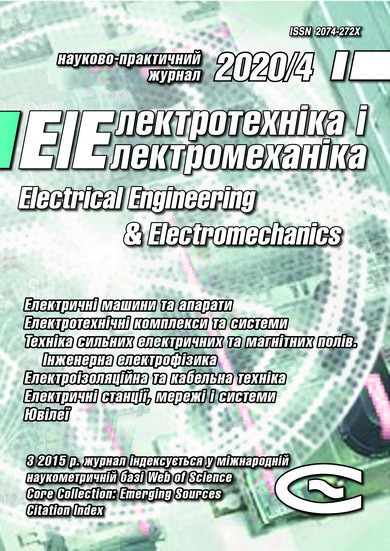RESEARCH OF ARC FURNACE ELECTRICAL MODE WITH A FUZZY CONTROL MODEL
DOI:
https://doi.org/10.20998/2074-272X.2020.4.05Keywords:
arc steelmaking furnace, electric mode, fuzzy control, autonomy, dispersionAbstract
Goal. The purpose of the paper is to increase the efficiency of arc steelmaking furnace (ASF) operating modes control basing on the improvement of arc lengths control model. Method. The control model is based on the fuzzy set theory, and the structural modelling methodology is used to study the dynamics indices. Results. The structural scheme of a furnace arc lengths fuzzy control system and the electrical mode (EM) coordinate control dynamics parameters values in response to the deterministic and random arc lengths fluctuations were obtained. Scientific novelty. For the first time, a fuzzy model of an EM mismatch signal generation with operational adaptation to its current state in each phase was developed, which enabled by-phase independent control of arc lengths and improved energy efficiency. Practical value. Dynamic accuracy of EM coordinates stabilization at the setpoint level is improved, in particular the arc currents dispersion is reduced, which leads to a corresponding power loss decrease in arc furnace short network, an increase of the furnace productivity, as well as to an improvement of the electromagnetic compatibility of the arc furnace and power supply network.References
Kazakov S.V., Garten, V. The 8th international Conference on Electrometallurgy of Steel (part I). Electrometallurgy, 2005, no. 12, pp. 36-43. (Rus).
Kudrin B.I. Retrospective and perspective views on electrical consumption in electrometallurgy. Electrometallurgy, 2003, no. 10, pp. 2-13. (Rus).
Lopukhov G.A. The state and tendencies of development of electro-smelting production (based on materials 33 of the IISI Conference). Electrometallurgy, 2000, no. 7, pp. 35-37. (Rus).
Maslov D.V. Razrabotka algoritmov i sistem upravleniia dugovymi staleplavil'nymi pechami, snizhaiushchikh polomki elektrodov. Avtoref. diss. kand. tehn. nauk [Development of algorithms and control systems for arc steelmaking furnaces that reduce electrode breakage. Abstracts of cand. techn. sci. diss.].Moscow, 2014. (Rus).
Lyuta A.V. Udoskonalena systema upravlinnia pryvodom peremishchennia elektrodiv duhovykh staleplavylnykh pechei Avtoref. diss. kand. tehn. nauk [Improved control system for moving water of electrodes of arc steelmaking furnaces. Abstracts of cand. techn. sci. diss.]. Donetsk, 2013. (Ukr).
Lozynskyi O., Paranchuk Y., Stakhiv P. The study of dynamics of the two-loop arc furnace electric mode ACS on a Simulink-model. Przeglad Elektrotechniczny, 2018, no. 12, pp. 24-27. doi: 10.15199/48.2018.12.06.
Lozinskii, O.Y., Paranchuk, Y.S. System for the optimum control of the electrical conditions of an arc furnace powered through a controlled reactor. Russian Metallurgy (Metally), 2007, no. 8, pp. 737-743. doi: 10.1134/S0036029507080204.
Nikolaev A.A., Kornilov G.P., Anufriev A.V., Pekhterev S.V., Povelitsa E.V. Electrical optimization of superpowerful arc furnaces. Steel in Translation, 2014, vol. 44, no. 4, pp. 289-297. doi: 10.3103/S0967091214040135.
Mees H., Hohl J., Krüger K. Dynamic Condition-Based Scrap Melt Control: Results of the Application at Thyssenkrupp Nirosta in Bochum. 10th European Electric Steelmaking Conference, Graz, 25-28 September, 2012.
Nikolaev A.A., Tulupov P.G. Development of the improved control algorithms for ultra-high power electric arc furnace EAF-250 electrode motion system. Electrotechnical Systems and Complexes, 2015, no. 3 (28), pp. 20-27. (Rus).
Nikolaev A.A., Kornilov G.P., Povelitsa E.V., Tulupov P.G. Study of different methods to design automated electrode position control systems for electric arc furnaces and ladle furnaces. Vestnik of Nosov Magnitogorsk State Technical University, 2015, no. 2, pp. 90-100. (Rus).
Nikolaev A.A., Tulupov P.G. Method of setting optimum asymmetric mode of operation of electric arc furnace. 2016 11th France-Japan & 9th Europe-Asia Congress on Mechatronics (MECATRONICS) /17th International Conference on Research and Education in Mechatronics (REM), Jun. 2016. doi: 10.1109/mecatronics.2016.7547111..
Nikolaev A.A., Tulupov P.G., Savinov D.A. Mathematical model of electrode positioning hydraulic drive of electric arc steel-making furnace taking into account stochastic disturbances of arcs. 2017 International Conference on Industrial Engineering, Applications and Manufacturing (ICIEAM), May 2017. doi: 10.1109/ICIEAM.2017.8076205.
Nikolaev A., Povelitsa E., Kornilov G., Anufriev A. Research and development of automatic control system for electric arc furnace electrode positioning. Applied Mechanics and Materials, 2015, vol. 785, pp. 707-713. doi: 10.4028/www.scientific.net/amm.785.707.
Lozynskyy O., Paranchuk Y., Paranchuk R. Fuzzy control law of electrode travel in arc steelmaking furnace. 16th International Conference on Computational Problems of Electrical Engineering (CPEE), Sep. 2015. doi: 10.1109/cpee.2015.7333349.
Paranchuk Ya.S., Paranchuk R.Ya. Neural network system for continuous voltage monitoring in electric arc furnace. Naukovyi Visnyk Natsionalnoho Hirnychoho Universytetu, 2016, no. 2 (152), pp. 74-80.
Lozynskyy O., Paranchuk Y., Kobylianskyi O. Simulink model of electric modes in electric arc furnace. 2017 IEEE International Young Scientists Forum on Applied Physics and Engineering (YSF), Oct. 2017. pp. 54-57. doi: 10.1109/YSF.2017.8126591.
Downloads
Published
How to Cite
Issue
Section
License
Copyright (c) 2020 Y. S. Paranchuk, R. Y. Paranchuk

This work is licensed under a Creative Commons Attribution-NonCommercial 4.0 International License.
Authors who publish with this journal agree to the following terms:
1. Authors retain copyright and grant the journal right of first publication with the work simultaneously licensed under a Creative Commons Attribution License that allows others to share the work with an acknowledgement of the work's authorship and initial publication in this journal.
2. Authors are able to enter into separate, additional contractual arrangements for the non-exclusive distribution of the journal's published version of the work (e.g., post it to an institutional repository or publish it in a book), with an acknowledgement of its initial publication in this journal.
3. Authors are permitted and encouraged to post their work online (e.g., in institutional repositories or on their website) prior to and during the submission process, as it can lead to productive exchanges, as well as earlier and greater citation of published work.





